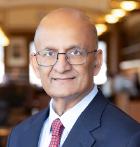哈佛大學商學院的一些老師談新世紀重要趨勢
Executive Summary:
HBS Dean Nitin Nohria and faculty look backward and forward at the most important business trends of the young twenty-first century.
About Faculty in this Article:

Nitin Nohria is the Dean of Harvard Business School.
About Faculty in this Article:

Teresa Amabile is the Edsel Bryant Ford Professor of Business Administration at Harvard Business School.
About Faculty in this Article:

Carliss Y. Baldwin is the William L. White Professor of Business Administration at Harvard Business School.
About Faculty in this Article:

Francesca Gino is an associate professor in the Negotiations, Organizations, and Markets Unit at Harvard Business School
About Faculty in this Article:

Linda A. Hill is the Wallace Brett Donham Professor of Business Administration at Harvard Business School.
About Faculty in this Article:

Michael I. Norton is an associate professor in the Marketing unit at Harvard Business School.
About Faculty in this Article:

Richard Vietor is the Paul Whiton Cherington Professor of Business Administration at Harvard Business School.
HBS Working Knowledge recently celebrated its tenth birthday, and we mark the occasion by looking back and looking forward. We've asked HBS Dean Nitin Nohria and a number of faculty to both remark on what they view as the most significant business management ideas of the first decade of the twenty-first century, and then to tell us what they hope will be the most fertile areas of business research between now and 2020.
But we didn't leave it there. Professor Jim Heskett is moderating a similar discussion with HBS Working Knowledge readers, and we encourage you to participate. As of this writing some 75 comments have been submitted.
Finally, I thought you would be interested in learning the most popular WK articles since we set up shop. You can see the results here.
Thank you to our more than 2 million annual visitors who have supported and contributed to this publication over its first decade, and our growing list of followers on Facebook. We promise to keep you at the cutting edge of emerging business research and trends over the next 10 years.
—Sean
HBS Dean Nitin Nohria
Globalization, enabled and accelerated by technology, has had a greater impact on business (and, indeed, on society) than any other development in the past decade. The western dominated economy and society of the past century has yielded way to a new global century, in which no one country or region enjoys an undisputed advantage.
Instead, we are seeing multiple players competing on a world stage, including emerging economies like China, India, and Brazil. This list will continue to grow. A by-product of the intertwining of globalization and technology enabled networks is that events are no longer isolated, the impact of which was on vivid display during the global economic crisis and the recent uprisings in Tunisia and Egypt.
Going forward, we are entering into a time of limitless possibilities when it comes to the role of business in the world. Yet we also face serious societal challenges that, if not addressed, will limit the extent to which we can realize those opportunities.
In the coming decade I believe the research agenda at business schools will be driven by the desire to apply management principles to addressing complex social problems (like balancing energy security with environmental sustainability), whose solutions lie at the intersection of academic disciplines. Disciplinary expertise will continue to be the bedrock of the academy but the boundaries that separate schools and faculties will melt away. This trend has already taken hold at Harvard, where faculty from across the University are building formal and informal networks around issues like health care and the environment.
Teresa Amabile
Over the past decade, nothing has had a more profound impact on business management than information technology. Ten years ago, many of us in business, academia, and government were wondering where it was all going. The tech bubble had burst and, although there were several survivors, the future of e-commerce and other info tech industries seemed perilous.
BusinessWeek.com recently ranked Amazon #6 in its annual list of most innovative companies; four of the other five are internet or computer businesses. In all its forms, info tech now reaches every aspect of business strategy and organizational management. Products are being developed through open innovation, with input from people connected to each other and the company only through a common interest—and electronic media. Virtually every company on the globe, including the tiniest startup, has a website. Internet-based companies like Google record every click and keystroke of every customer, analyzing the data to continuously improve their products and marketing. Customers are courted and supply chains are managed via websites, social media, and email; marketing, manufacturing, and distribution processes are managed by sophisticated real-time information systems; colleagues working 12 time zones apart can see and hear each other as they work at their desks—or in airport lounges on opposite sides of the planet. Publications, like this one, have abandoned paper. Cell phones serve up information and entertainment more often than phone conversations. News on innovations and revolutions in far-flung regions is available instantaneously.
These changes, and hundreds more resulting from an explosion of info tech, have changed the nature of business by dramatically shifting markets; enabling massive global competition and cooperation; and altering the attitudes, values, motivations, aspirations, and fears of customers and employees. Perhaps most importantly, these changes have altered human societies, promising a coming decade of unpredictable and unprecedented change.
In my view, psychology is the most fertile area for business research in the next decade. By more deeply understanding human cognition, emotion, motivation, and behavior, managers could tailor products and services to unmet and previously unrecognized needs with exquisite accuracy. They could customize their marketing of those products and services to match the specific interests and desires of individual people in diverse societies around the world. They could create solutions enabling people to cope with and leverage the exploding volume of information available 24/7. They could attract, retain, develop, and motivate employees much more effectively—creating high-performance teams reliably, matching people to projects that fit both their skills and their interests, and dramatically increasing the probability that work will be productively creative.
We psychological researchers have new tools at our disposal that we could only dream of just a few years ago, ranging from unobtrusive physiological and neurological measures to massive databases on billions of individuals' decisions about consuming, saving, investing, and living their lives. As psychological theories and methods become ever more integrated into economics research, business academics and managers will have the power to substantially improve both the practice of business and the welfare of society. My hope is that we will use that power responsibly.
Carliss Y. Baldwin
The two trends with greatest impact on business management in the last decade have been (1) the rise of business ecosystems caused by falling transaction costs; and (2) the empowerment of users caused by the global spread of communication technologies.
A business ecosystem is a group of firms that together provide complex products and related services to end users. Examples include the computer and telecommunication ecosystem, the health care ecosystem, and the global financial ecosystem.
In the last ten years, ecosystems have emerged as an important form of economic organization, replacing the large vertically integrated firms that dominated the era of mass production. Importantly, firms are not the only entities to participate in the new ecosystems. The Internet and other social media have dramatically lowered the cost of communication and collective action, and thus users are increasingly taking an active role as co-designers and stewards of the products and services they consume. In many cases, collaborative user innovators are vying with producers for intellectual property rights and the control of standards and innovation trajectories.
In light of these developments, it is time to abandon the dated myths of heroic inventors and farsighted corporations as the main sources of innovation in our economy. Innovation proceeds differently in business ecosystems than in pre-industrial markets or ring-fenced corporations. Innovation in ecosystems requires collective action to both invent and appraise, efficient, cross-organization knowledge flows, modular architectures, and good stewardship of legacy systems. It rests on multiple, complementary platforms. It requires intellectual property rights to be present, but not too strong. Finally, it requires participants—both users and producers—to be aware of the whole, and not just their local piece of the action. When participants do not "see" or feel responsible for the whole, a dynamic ecosystem can easily evolve into a state of dangerous instability, as in the financial crisis of 2008-09, or even collapse, as in the Internet bust of 1999-2000. Thus investigating the structure and dynamics of innovative ecosystems holds great promise for significant scholarly work over the next decade.
Francesca Gino
The last decade has documented several ethical failures which have caused remarkable harm, including those of individuals like Bernie Madoff and of corporations like Enron, Worldcom and many others. In fact, a recent estimate from the Association of Certified Fraud Examiners indicates that U.S. businesses lose approximately 7 percent of their annual revenues to various forms of unethical behavior, an amount equal to a trillion dollars in losses across the economy.
Why do seemingly ethical people consistently engage in unethical behavior? Over the last ten years researchers have started to explore this question. An emerging and very promising literature has begun to identify the importance of psychological factors that influence, consciously and unconsciously, people's decisions to cross ethical boundaries. What this research suggests is that everyone, regardless of their ethical foundations, has the capacity to behave dishonestly. In fact, most individuals start with good intentions, but ultimately engage in unethical behavior because of subtle situational influences - including the behavior of peers and co-workers, the goals set for employees, or even the amount of lighting in a room.
This research is already having an important impact on business management. Many leading scholars in the management field are teaching about these findings in the classroom so as to influence what will eventually happen in the boardroom. However, many open questions remain about the factors that enable even people with good intentions to commit unethical acts. What are the tools organizations and their managers can effectively use to remind employees of their moral compass? How can we assure ethical principles are salient when employees and managers are at greatest ethics risk in the course of their work? What are effective fixes to our moral bugs?
I hope that both leading researchers and young scholars will continue their search for answers to these important questions in the next decade. And I hope that through their research they'll uncover ways in which we can equip ourselves with tools that can help us navigate through complex ethical choices.
Linda A. Hill
The most important trend of the 21st century for business management—the increasing importance of the emerging markets. Companies are now taking seriously the need to be truly global. How do we develop leadership able to work in diverse markets with ever more demanding stakeholders (employees, customers, communities) around the world? How do will build the meritocracies that talented people will demand if companies want to retain and engage them?
Many have yet to figure out how to effectively harness the diverse talents within their own countries. And of course in the emerging economies the demographics are such that it is the young we must attract and nurture—the young are eager to rewrite the psychological contract between themselves and employers. They work to make a living, but also they aspire to find purpose and meaning in what they do.
We in the academy have much intellectual capital to develop to help organizations address the challenges and opportunities associated with globalization. Our work has not been as global as it should be. Too much of the research is based on organizational life in the West. In addition, I suspect we need to reframe our understanding of what makes for effective leadership. How can a single leader set direction and inspire people to follow him or her given the dynamism and complexity of the global economy? Take the CEO of IBM who now heads a company of 400,000 full time employees and I suspect as many contract employees all around the world. How can we expect him to set direction and inspire them to follow; instead of vision-based leadership, he has pursed what he refers to as values-based leadership. To quote Nelson Mandela, "a leader is like a shepherd … he stays behind the flock, letting the most nimble go on ahead, whereupon the others follow, not realizing that all along they are being directed from behind."
The leadership task is changing. It will become more about shaping the context in which communities of practice willing and able to innovate are nurtured and encouraged to respond to the exciting opportunities that will emerge in the coming decade.
Michael I. Norton
In my mind, the biggest single development for business in the last decade is the dramatic increase in the number of companies concerned with corporate social responsibility, and the resultant rise in the range and variety that such efforts have taken. From "old" models in which companies either donated money directly to charity or encouraged consumers to buy their products by donating a fixed percentage to charitable causes (think Newman's Own), newer models have amped up customer engagement.
Take the recent Pepsi Refresh Project: Rather than donate, say, $.05 from every bottle purchased to some charitable cause, Pepsi encouraged users to submit projects with social impact—from cleaning up a river to saving animals—and allowed other users to vote on which projects Pepsi should fund. Or consider DonorsChoose.org, which allows donors to contribute funds directly to low income classrooms, buying books for kids and teachers who need them; corporate partners such as Crate and Barrel have sent DonorsChoose.org "gift certificates" to their customers, empowering their customers to donate to whichever school they choose.
In the next decade, my hope is that corporations will continue to pursue CSR-related activities, and most importantly continue to encourage direct customer participation in such activities—as with Pepsi and DonorsChoose.org. Customer involvement is key for two reasons: First, it increases the "bang" for every chartable buck, as consumers truly interact with the brand in order to support the causes they care about.
Second and perhaps even more importantly, engaging in CSR-activities on a customer-by-customer basis allows firms to calculate a return-on-investment for such activities: Do customers who we involve in our charitable causes "pay us back" with increased brand loyalty and repurchase rates? Simple experiments - sending some customers charity vouchers and others more standard product discounts (15% off your next purchase)—will allow companies to compare directly the ROI on charitable actions versus more traditional marketing actions - and hopefully make the case for increased focus on the former than the latter.
Richard Vietor
In the first decade of the 21st century, two macroeconomic trends have dominated the global economy.
First, a huge asymmetry in current account balances evolved, and continues to remain unresolved. The US runs massive deficits on its current account (balance of trade in goods, services, income, and transfers); Italy, the UK, Spain and Australia also run significant deficits. These countries now import far more than they export, and have savings that are far less than their needed investment. Surpluses, on the other hand, are run by China, Japan, Saudi Arabia and Russia. This results in a financial flow, where the debt of deficit countries is bought by surplus countries, who now own several trillion dollars of foreign assets.
A related problem are the fiscal (government budget) deficits run by the United States, Japan, and most European countries. These worsened significant in the 2000s, due to slow growth in Japan, massive tax cuts in the USA, and expensive social programs in Europe. This now adds to the financing problem.
By 2011, these deficits have become almost overwhelming, leading to debt crises in Greece, Ireland, Spain and perhaps Portugal, further stagnation in Japan, and an overwhelming deficit problem to be faced by the Obama administration. 













